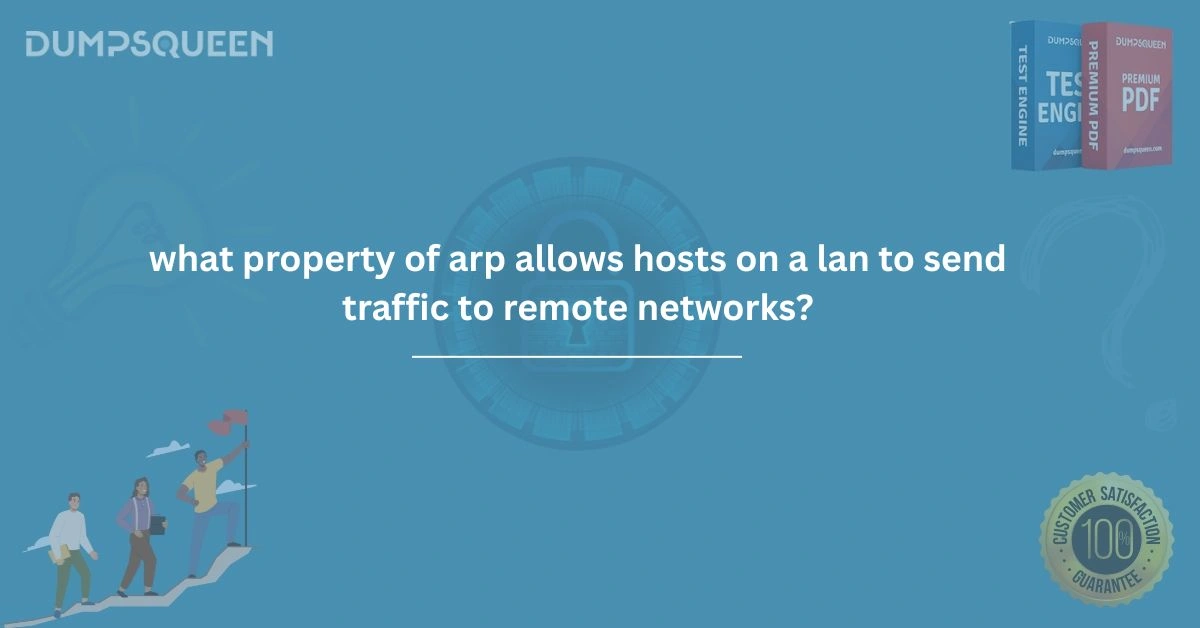Introduction
In the complex yet structured world of networking, several technologies and protocols work together seamlessly to provide the connectivity we often take for granted. Among them, the Address Resolution Protocol (ARP) stands out as one of the core mechanisms that allow communication between devices within and outside a local area network (LAN). Understanding ARP in depth not only reveals how devices discover each other on the same network, but also explains a critical property what property of ARP allows hosts on a LAN to send traffic to remote networks? This question is particularly relevant for networking professionals and students preparing for certifications, such as those offered by DumpsQueen, where mastering foundational protocols is key to exam success. Whether you're diving into the world of CCNA, CompTIA, or other industry-recognized certifications, grasping how ARP enables devices to communicate across boundaries is essential. To appreciate how ARP facilitates traffic to remote networks, we must dissect its functional role, its relationship with IP addressing and MAC addressing, and how the concept of a default gateway brings it all together.
Understanding ARP and Its Role in Networking
ARP, or Address Resolution Protocol, is a network protocol used to map a known IP address to a corresponding MAC address. Operating at the boundary between the OSI model’s Data Link Layer (Layer 2) and Network Layer (Layer 3), ARP serves as a bridge between logical addressing and physical addressing. When a host wants to send data to another device, it must first determine the MAC address of the recipient. This is because actual data transmission over Ethernet occurs using MAC addresses. If the destination IP is on the same subnet, ARP is used to directly obtain the MAC address of the device. However, if the destination is on a remote network, the process becomes more intricate and this is where the critical property of ARP comes into play.
What Happens When a Host Sends Traffic to a Remote Network?
Here’s where the question becomes truly interesting: What property of ARP allows hosts on a LAN to send traffic to remote networks? The answer lies in ARP’s ability to resolve the MAC address of the default gateway. When a host determines that the destination IP address is not part of its local subnet, it doesn’t try to ARP the destination directly. Instead, it uses the IP address of its configured default gateway (often a router). ARP then resolves the MAC address of the default gateway, and the packet is sent to that gateway for further routing. This process illustrates that the most important property of ARP in this context is its function to resolve the MAC address of the next-hop IP address, which is often the default gateway. In other words, ARP allows the host to encapsulate the IP packet within a frame addressed to the MAC address of the gateway, which in turn forwards the packet to the appropriate remote network.
Deep Dive into the ARP Process for Remote Communication
To understand this at a deeper level, let’s consider a real-world scenario. Assume Host A with an IP address of 192.168.1.10 wants to communicate with a remote server at 10.0.0.5. Host A knows it is not on the same network (based on its subnet mask, say 255.255.255.0), so it looks up its routing table and finds the default gateway is 192.168.1.1. Now, Host A must determine how to physically send the data. Here's what happens:
-
Host A checks its ARP cache for an entry for 192.168.1.1.
-
If there is no entry, it sends an ARP request: “Who has 192.168.1.1? Tell 192.168.1.10.”
-
The router at 192.168.1.1 replies with its MAC address.
-
Host A stores this mapping in its ARP cache.
-
Host A sends the packet, encapsulated in a frame with the router’s MAC address as the destination.
This entire process is powered by ARP’s core property: it always resolves the MAC address of the next-hop IP address. It doesn’t need to know how to reach the final destination; it only needs to know how to reach the next hop, which in this case is the router.
Importance of Default Gateway in the ARP Process
The default gateway is a critical component in inter-network communication. When a host is configured with a default gateway, it essentially has a way to access destinations outside its local subnet. ARP’s job is to ensure that the host can deliver the data to that default gateway. This setup abstracts the complexity of routing. The host doesn’t need to know the route to every possible destination IP; it only needs to trust that its default gateway does. ARP ensures that the communication channel between the host and its gateway is functional at the Data Link Layer. Therefore, the property of ARP that allows hosts on a LAN to send traffic to remote networks is its ability to resolve the MAC address of the default gateway. This simple yet powerful mechanism is what enables the entire system of hierarchical networking to work smoothly.
How ARP Differs in IPv6 Environments
While this discussion focuses primarily on IPv4, it’s worth noting that IPv6 uses a different mechanism known as Neighbor Discovery Protocol (NDP) to perform similar functions. NDP, like ARP, helps resolve MAC addresses, but it operates with additional capabilities such as router discovery and prefix discovery. Still, the underlying principle remains: the host must know the MAC address of the next-hop IP to send data, and some protocol (ARP or NDP) must facilitate this.
Real-World Application in Networking Exams
For certification candidates using resources from DumpsQueen, it’s important to understand how this principle may appear in exam questions. A typical question may ask how a host sends data to a remote IP address or may ask you to interpret an ARP table or routing table. Grasping the role of ARP in this sequence of events is crucial for accurate answers. Let’s look at how this concept might appear in multiple-choice exam scenarios.
Free Sample Questions
Question 1: What property of ARP allows hosts on a LAN to send traffic to remote networks?
A. It resolves the IP address of remote hosts
B. It resolves the MAC address of the destination IP directly
C. It resolves the MAC address of the default gateway
D. It broadcasts all packets to remote networks
Answer: C. It resolves the MAC address of the default gateway
Question 2: When a host determines the destination IP is not within its subnet, what is the next step?
A. It sends an ARP request to the destination IP
B. It sends the packet directly using the IP header
C. It drops the packet
D. It sends an ARP request for the default gateway’s IP
Answer: D. It sends an ARP request for the default gateway’s IP
Question 3: Why does ARP not resolve the MAC address of a remote host directly?
A. Because MAC addresses are not used outside the LAN
B. Because the remote host has a different MAC format
C. Because IP packets are only used within local networks
D. Because routers block ARP broadcasts
Answer: A. Because MAC addresses are not used outside the LAN
Question 4: Which of the following best describes how ARP works with the default gateway?
A. ARP contacts the DNS to find the gateway IP
B. ARP sends an IP request to the gateway for forwarding
C. ARP resolves the MAC address of the gateway to deliver frames
D. ARP creates a new subnet for remote routing
Answer: C. ARP resolves the MAC address of the gateway to deliver frames
ARP Cache and Its Role in Performance
Every host maintains an ARP cache, which stores IP-to-MAC mappings temporarily. This reduces the number of broadcast requests needed, thus improving performance and reducing network traffic. When a host needs to send data, it first checks this cache. If the necessary MAC address is found, ARP doesn’t need to send a broadcast. This is also a good reminder for certification candidates and IT professionals to understand ARP cache behavior, how it’s managed, and how to clear or troubleshoot it when needed. Some systems allow manual ARP entry for static networks, which is a valuable concept in advanced network design.
Security Considerations: ARP Spoofing
While ARP is a foundational protocol, it was not designed with security in mind. This has led to potential vulnerabilities, including ARP spoofing or ARP poisoning, where an attacker sends falsified ARP messages to associate their MAC address with the IP of another device often the gateway. This can result in traffic interception or denial of service. Understanding how ARP works also prepares IT professionals to defend against such attacks using methods like Dynamic ARP Inspection (DAI), which is taught in more advanced networking courses, many of which are supported through DumpsQueen’s certification guides.
Conclusion
In the layered world of network communication, the Address Resolution Protocol performs a critical bridging role between logical and physical addressing. To specifically answer the central query what property of ARP allows hosts on a LAN to send traffic to remote networks? it is the protocol’s ability to resolve the MAC address of the default gateway that enables this functionality. Without this capability, devices would have no way to physically send packets beyond their local subnet. By mapping the IP address of the next-hop gateway to a MAC address, ARP ensures that data can begin its journey toward remote destinations. For networking professionals and certification candidates alike, mastering this fundamental concept is essential. Resources like those available at DumpsQueen can help learners solidify their understanding through practice exams, study guides, and hands-on labs. With this knowledge, navigating the layers of the OSI model and protocols like ARP becomes not only manageable but empowering.




